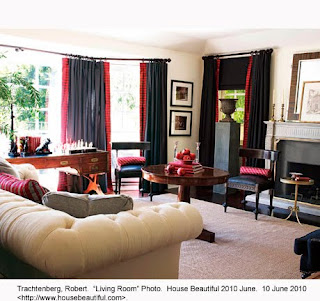Today we are going to answer your valance questions. Like: "How long should a valance be", "What style is masculine/feminine?", and "What rooms to use different styles in?". We aren't able to cover all valance styles, so we are discussing the ones that are most versatile. Keep in mind that all of the valance styles can be used alone or with a drapery panel.
When choosing a valance you want to make sure it is long enough. Normally a valance is mounted four inches above a window (unless it is mounted inside the window moulding) and covers about eight inches of the window. You don't want it to look like you ran out of fabric and the valance didn't get finished. If it is too short it will break the flow of the space, and look unprofessional. But, don't go overboard the other direction and turn your valance into a drapery panel that covers the whole window.

The first style is of the basic box pleat valance. It looks just as it names describes, like it could be going around a box. The basic box pleat looks clean and sophisticated. Having the clean lines makes it either feminine or masculine.
This basic box pleat goes well in master bedrooms, kitchens, great rooms. Really any room you can think of.
Here is an example of a more boyish style, box pleat valance. It would compliment a young boys bedroom well. Adding that softness to the window with out being girly. The magazine feature also talks about it being used in a playroom.
Now this is one of our favorites. It is a more whimsical box pleat with the curves at the bottom. Due to the curves it has more of a feminine feel to it. This style would go well in a teenage girl's room or a fun craft or hobby space. The use of the curves gives it a girly feeling without making it feel juvenile.
The pencil pleat valance is the final style we will be talking about today. Pleating the valance gives it amore feminine feel with out making it look fruffie and outdated. Adding this valance to a living room, girls bedroom, or even a nursery can add a bit of style with out going overboard.
For more great valance ideas check out House Beautiful, Southern Accents, and Country Living. They all offer great ideas with visuals. Helping you picture what it will look like in your space.
Remember when choosing that it isn't too short or too long. You want it to look professional and complete the space. Also, don't forget to choose the style the compliments the room it is going in. So, don't choose a feminine style for a boys bedroom.
The images come from the House Beautiful magazine's feature of "Jim Howards pattern book of valances".














